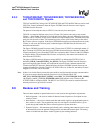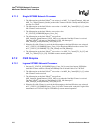
282 Hardware Reference Manual
Intel
®
IXP2800 Network Processor
Media and Switch Fabric Interface
8.6.1 Data Training Pattern
The data pin training sequence is shown in Table 107. This is a superset of SPI-4 training sequence,
because it includes the TPAR/RPAR and TPROT/RPOT pins, which are not included in SPI-4.
8.6.2 Flow Control Training Pattern
This section defines training for the flow control pins (Table 108). These pins are normally used for
CSIX flow control (Section 8.5), but can be programmed for use as SPI-4 Status Channel. The
training pattern used is based on the usage.
The flow control pin training sequence when the pins are used for CSIX flow control is shown in
Table 108.
Table 107. Data Training Sequence
Cycle
(Note 4)
PROT
PAR
CTL
DATA
1514131211109876543210
1 (Note 5) 0x10xx000000000abcd
2 to 11 0110000111111111111
12 to 21 1001111000000000000
20α-18 to 20α-90110000111111111111
20α-8 to 20α+1 1001111000000000000
NOTES:
1. In cycle 1, x and abcd depend on the contents of the interval after the last preceding control word. This is
an Idle Control Word.
2. α represents the number of repeats, as specified in SPI-4 specification. When the IXP2800 Network
Processor is transmitting training sequences the value is in Train_Data[Alpha].
3. On receive, the IXP2800 Network Processor will do dynamic deskew when Train_Data[Ignore_Training]
is 0, and RCTL = 1 and RDATA = 0x0FFF for three consecutive samples. Note that RPROT and RPAR are
ignored when recognizing the start of training sequence.
4. These are really phases (i.e.,each edge of the clock is counted as one sample).
5. This cycle is valid for SPI-4, it is not used in CSIX training.
Table 108. Flow Control Training Sequence
Cycle
(Note 3)
XCSOF
XCDAT
XCPAR
XCSRB
3210
1 to 10 1110000
11 to 20 0001111
20α-19 to 20α-10 1110000
20α-9 to 20α 0001111
NOTE:
1. α represents the number of repeats, as specified in SPI-4 specification. When
the IXP2800 Network Processor is transmitting training sequences the value is
in Train_Flow_Control[Alpha].
2. On receive, the IXP2800 Network Processor will do dynamic deskew when
Train_Flow_Control[Ignore_Training] is 0, and RXCSOF = 1, RXCDATA =
0xC, RXCPAR =0, and RXCSRB = 0 for three consecutive samples.
3. These are really phases (i.e.,each edge of the clock is counted as one sample).


















